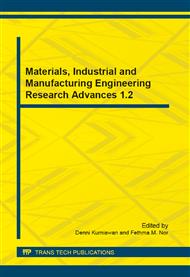p.55
p.61
p.67
p.73
p.79
p.85
p.89
p.93
p.99
Preferred Growth Orientation of Cementite Carbide by Phase-Field Simulation
Abstract:
A morphological evolution of the crystals growth has been investigated using two dimensional (2D) multi-phasefield (MPF) simulations. Cementite carbide growth is taken as an example in the present case, while concern is given in simulating the preferred growth orientation of the carbide. In order to evaluate competitive growth between carbide seeds, variations on carbide seed orientation have been implemented. In the present model, variation of the seed orientations are embedded on the interfacial energy, thereby the anisotropy characteristic of interfacial energy can be obtained. Simulation utilized homogenous grain orientation that less than the preferred growth orientation results insignificant grain growths (first case). In the opposite way, simulation utilized homogenous grains orientation that equal or more then the preferred growth orientation, results in the homogenous significant grain growth (second case). On the other hand, simulation utilized heterogenous grains orientation involving grains in the first and second case, results a competition growth that inhibit and diminish the grains in the first case. It can be concluded that the present simulations works can shows the existence of preferred orientation growth during grain growth phenomena including the growth of cementite carbide phase.
Info:
Periodical:
Pages:
79-83
Citation:
Online since:
August 2014
Authors:
Price:
Сopyright:
© 2014 Trans Tech Publications Ltd. All Rights Reserved
Share:
Citation:


